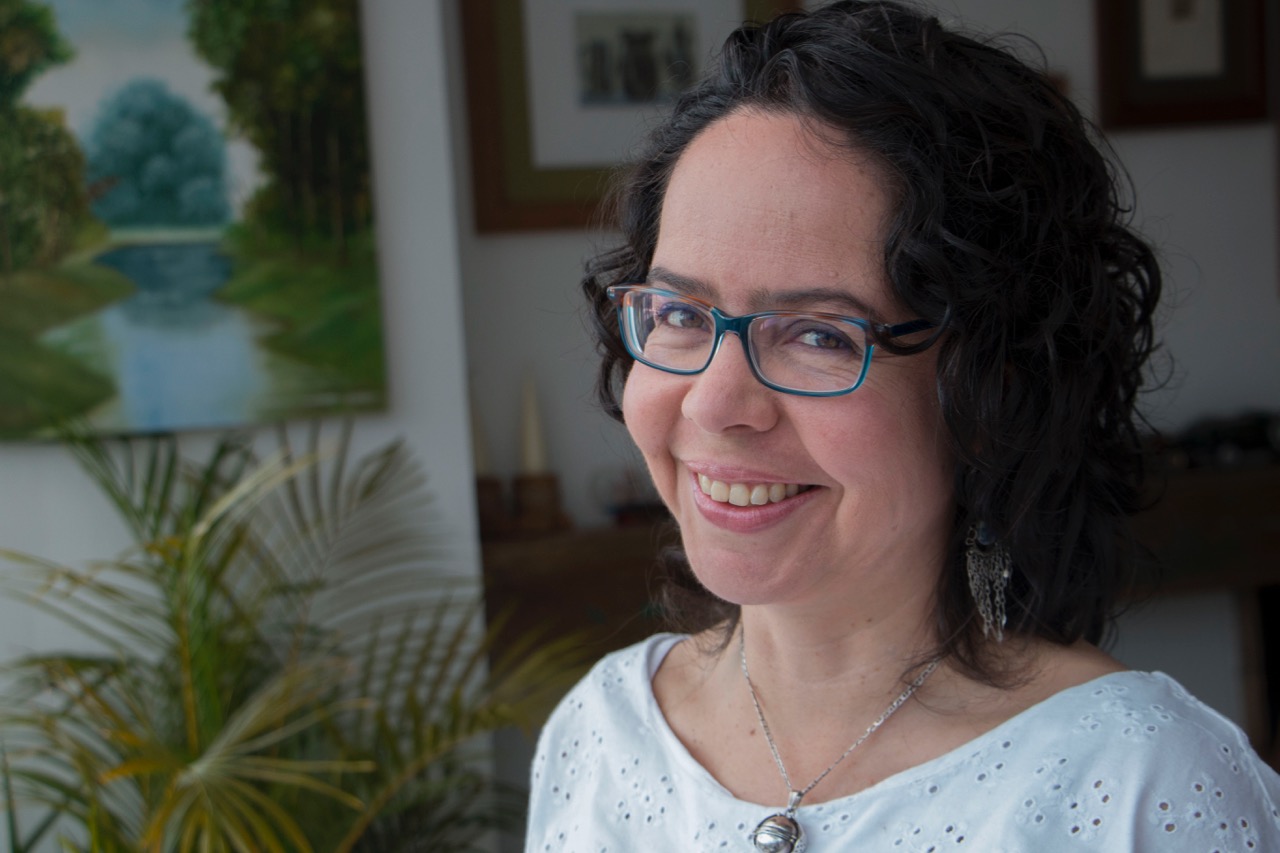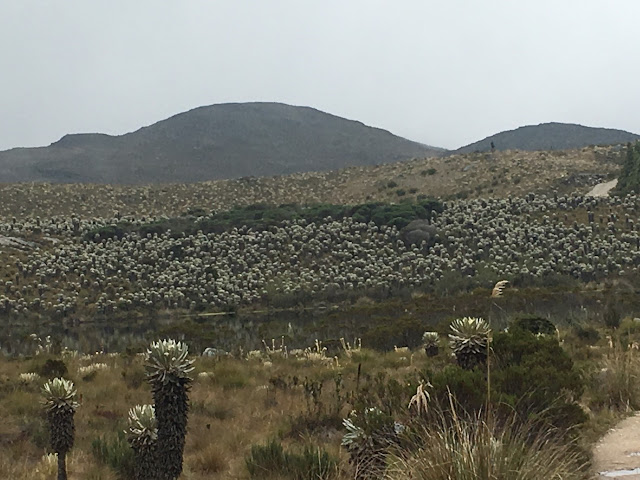Many believe that keeping feelings, emotions, individualities and identities out of the field, the lab and the experiment is the golden rule that guarantees the validity of scientific work. From this perspective, good science requires neutrality and objectivity.
I’m not so sure, and today I want to share stories about the feelings and emotions I have lived with BIOsmart, a project where British, Colombian, Chilean, Irish and Spanish citizens work together, and tell you about how my emotions have made me reflect on what we may mean by good science.
 |
| María Paula delighted with her walking stick, lovingly crafted by one of our drivers. |
I’ll start by saying that I am both Colombian and British. I have lived in the UK for 20 years now and when I have brought the UK team to do fieldwork in Colombia, I have felt pride and joy in having them taste our ajiaco, arepas, empanadas and aguardiente, and feast on the bounty of colours, textures and tastes of our fruit markets. I have felt pride too because my fellow Colombians always greet us with our traditional warmth and cheeky humour and this has put a finger on my nostalgia as an immigrant; for this warmth, the easiness with which we smile and become best friends in a matter of minutes, are what I most dearly miss when I am in England. But this nostalgia is mixed with gratitude, for the academic system in the UK has allowed me to return to Colombia and work for people I love. My identity matters and is at the heart of the passion and commitment with which I work.
These feelings are replenished at every farm visit we make. Coffee, freshly squeezed lemonade, home-made juices and yogurts, even hot chocolate made with home-grown cocoa beans are always waiting for us. We reciprocate this generosity and always arrive with fresh bread from the bakeries and meal by meal we learn about farmers’ lives in Caquetá and they learn about our own lives in the UK. This learning happens outside the lab, before we start counting plants and insects and before we begin the formal interview. This learning, and the feelings of respect, solidarity and gratitude that come with it, is inconspicuous in the data that will go into papers and presentations; but without it, our research practice would be less meaningful for all involved. This learning, imbued with emotions, is what gives real meaning to our work and I feel pride in the British team too, for I have seen them care about the farmers and our Colombian partners as much as I do. This shows in the friendships they have built and the character with which they work. They have spent time with farmers’ children, they have kept in touch with farmers, drivers and colleagues. It shows too when we get up at the crack of dawn because we want to be as hard-working as the farmers and the Colombian team of scientists who are already waiting for us: we don’t want to be late and mess up their day. Good science cares, so we are out in the cars by six in the morning. I was moved by how this caring goes both ways. My aging body and my city lifestyle makes it tricky for me to walk in this hilly and boggy terrain. The drivers have become part of the team too and, one of them surprised me one day with a gift. He had chosen a branch from a guava tree, peeled it and polished it and crafted a beautiful walking stick that I have with me.
 |
| The farmers always showed us great hospitality, we even enjoyed hot chocolate made with homegrown cacao beans. Photo: María Paula. |
But there have been other kinds of emotions too. Too often, farmers apologise for their lack of formal education and tell us how this makes them feel ignorant and inferior. This has made me feel angry, for I know this lack of formal education and this sense of inferiority are the result of a political, economic, social and cultural system, of global dimensions, that neglects and despises peasants. On every occasion I tell farmers that their level of formal education does not reflect their worth and I tell them how they are knowledgeable in ways that humble us. I strive for our conversations to return to them the dignity they are owed. This has made me think about objectivity and neutrality. If being objective is the commitment to understand what the real problem is and good science is about caring, then I don’t want to be neutral. I have wanted to spend more time with them and contribute beyond the knowledge we are all creating.
 |
| Enjoying some downtime in Florencia. Teamwork is at the heart of BioSmart. |
Sometimes, these contributions have been real and immediate. After we finished the interview and we had become instant friends in the way Colombians do, a farmer told me they had come to the village that day not only to see me, but also to sell some chickens. They would have preferred to keep them for longer because then they would have sold for a better price. But they were short of money to pay the electricity bill and the only option was to sell the chickens. However, what they got was not enough and now, they did not have the chickens or the money to pay the bill. Chickens are income and food and electricity is essential. I gave them some of my own money. Some might think my gesture creates a culture of assistencialism, that what I ought to do is help them be more productive so they can improve their income and not have money problems. Perhaps, more cynical views would even question their story. I didn’t and even though my work is meant to help alleviate poverty in the long term, I felt I wanted to help there and then. Was I right to do so? I feel I was.
 |
| María Paula conducting an interview with a farmer in Caquetá, Colombia. |
This questioning of neutrality has been fuelled by other emotions too. For example, one morning, I felt deep sorrow and broke into a deluge of tears as I listened to a woman deliver an improvised fifteen-minute speech. Standing tall by the porch of her house, she wanted to know if we were visiting the farm on behalf of the oil and mining companies. She told us how their presence makes her fear for the future of her children and despair for the effects that extractive projects are having on the land she grew up in. She also told us how some project implementers, not all, have discriminated her and refused to sign her up to agri-environmental initiatives because she is a woman. We were all moved by her courage and her eloquence, including her husband and her children. What a brave mother and wife you have, I told them. As we said goodbye, we had a long and tight hug and again, I felt that I need and I want to do more.
Sometimes this feeling comes with urgency. At the time of writing, my heart is worried about a man who is thinking that selling his land, the most pristine of all the farms I visited, is his only option because he is in debt. The only way to earn a living is to have cows but he does not want to have cows: he would much rather look after the forest, but this does not provide him with a living. “Help me find a buyer”, he says, “but someone who cares for the forest just as I have”.
I feel rage for the injustices these people live in. I cannot and I don’t want to be neutral. I feel conflicted and wonder if I need to worry, for I am pondering how to be at once the researcher and the activist, the University employee and the solidarity campaigner. I want to help and, as I ponder how, I feel that what we mean by good science might be better practised from this place where my emotions and my research meet. I want to think my feelings and emotions articulate a goodness where impact is not only what comes at the end of the project, often in the shape of outputs or closure activities, but what touches and nurtures the lives of all involved from the beginning.
I want to think good science involves acknowledging emotions to the point of writing publicly about them. Vulnerability may be challenging, but embracing it enriches you as a person and as researcher: after all, one cannot be extricated from the other.
————————
 |
| María Paula Escobar-Tello |



